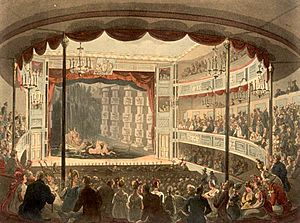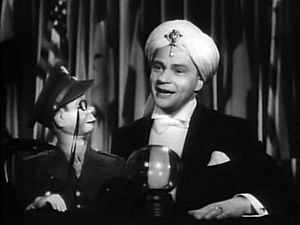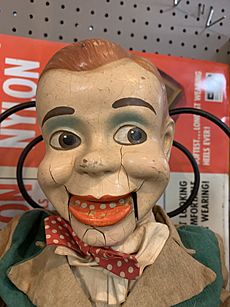Ventriloquism facts for kids
Ventriloquism is a cool performance art where a person, called a ventriloquist, makes it seem like their voice is coming from somewhere else. Usually, this "somewhere else" is a special puppet known as a "dummy." People often say that ventriloquists can "throw" their voice, making it sound like it's not coming from them at all!
Contents
The History of Ventriloquism
Ancient Roots: Speaking from the Stomach
Believe it or not, ventriloquism wasn't always about entertainment. Long ago, it was a religious practice! The word "ventriloquism" comes from Latin words meaning "to speak from the stomach." The ancient Greeks called it "gastromancy."
People used to think that the sounds coming from a ventriloquist's stomach were the voices of spirits or even people who had passed away. They believed ventriloquists could talk to the dead and even tell the future. One famous example was the Pythia, a priestess in ancient Greece. She was thought to be a channel for the gods' messages.
A very successful early "gastromancer" was Eurykles from Athens. Because of him, these belly-speakers were sometimes called Euryklides. Other cultures around the world, like the Zulu, Inuit, and Māori, also had traditions of using ventriloquism for special rituals or religious purposes.
From Rituals to Entertainment

The way ventriloquism changed from a spiritual practice to a fun show happened in the 1700s. It started appearing at travelling funfairs and markets. One of the first pictures of a ventriloquist is from 1754 in England. It shows a man named Sir John Parnell making his voice seem to come from his hand. In 1757, an Austrian performer named Baron de Mengen used a small doll in his act.
By the late 1700s, ventriloquism was a popular form of entertainment in England. Back then, many performers focused on "distant ventriloquism." This meant making their voice sound like it was coming from far away. This is different from today's "near ventriloquism," where performers use a puppet right next to them. Joseph Askins, a famous ventriloquist from the 1790s, would advertise his act as talks between himself and his "invisible familiar," Little Tommy.
However, some performers started using dolls or puppets. An Irishman named James Burne would carry "an ill-shaped doll" that seemed to speak.
The Golden Age of Ventriloquism
Ventriloquism really took off during the time of music halls in the United Kingdom and vaudeville shows in the United States. George Sutton started using a puppet in his act in the 1830s. But it was Fred Russell who is often called the "father of modern ventriloquism."
In 1886, Fred Russell got a professional job at the Palace Theatre in London. His act, which featured a cheeky boy dummy named "Coster Joe" sitting on his lap, was very important. This style of having a puppet talk back to the ventriloquist became super popular and was copied by many performers who came after him. There's even a special sign on one of Russell's old homes that says he was the "father of ventriloquism."

Fred Russell's successful comedy style was used by the next generation of ventriloquists. In Britain, Arthur Prince and his dummy Sailor Jim became some of the highest-paid entertainers. In America, The Great Lester, Frank Byron Jr., and Edgar Bergen became very famous.
Edgar Bergen made the idea of a funny ventriloquist very popular. He and his favorite dummy, Charlie McCarthy, had a radio show from 1937 to 1956. It was the number one show on the nights it aired! Bergen performed until he passed away in 1978. His popularity inspired many other famous ventriloquists like Paul Winchell, Jimmy Nelson, Jeff Dunham, and Darci Lynne.
Ventriloquism's popularity goes up and down. In 2010, there were only about 15 full-time professional ventriloquists in the UK, a big drop from around 400 in the 1950s and 60s. However, some modern ventriloquists have become very popular as live comedy grows. For example, Zillah & Totte won Sweden's Got Talent in 2007. Also, three ventriloquists have won America's Got Talent: Terry Fator in 2007, Paul Zerdin in 2015, and Darci Lynne in 2017.
How Ventriloquists Make Sounds
One tricky thing for ventriloquists is that they have to make all their sounds with their lips barely moving. For sounds like f, v, b, p, and m, which usually need your lips to touch, they have to replace them with other sounds. A funny example of this challenge is when less skilled ventriloquists try to say "bottle of beer" and it sounds like "gottle o' gear"! If sounds like th, d, t, and n are spoken quickly, it can be hard for listeners to notice the difference.
The Ventriloquist's Dummy
Today, ventriloquists use many kinds of puppets. Some are soft cloth or foam puppets. Others are flexible latex puppets. But the most classic type is the traditional hard-headed "knee figure." These puppets, technically called ventriloquial figures, can be different sizes, usually from about 34 to 42 inches tall.
Historically, these puppets were made from papier-mâché or wood. Now, they are often made from other materials like fiberglass, urethane, or neoprene.
Some famous people who made ventriloquist dummies include Jeff Dunham, Frank Marshall (who made Charlie McCarthy for Edgar Bergen), Theo Mack, and the McElroy brothers. The McElroy brothers' figures are known for having very complex movements, sometimes with up to fifteen different facial and head movements controlled by hidden switches! Jeff Dunham even called his McElroy figure, Skinny Duggan, the "Stradivarius of dummies," meaning it was a masterpiece.
Scary Dummies in Movies
Sometimes, in movies and TV shows, toy dummies are shown as being alive and scary. This idea has been used in many stories, like episodes of The Twilight Zone and Goosebumps, and even in Toy Story 4. This scary idea has also been made fun of in shows like ALF and Seinfeld.
Some psychological thrillers also feature ventriloquists who believe their dummies are real and use them to do frightening things. Examples include the 1978 film Magic.
See also
 In Spanish: Ventriloquía para niños
In Spanish: Ventriloquía para niños
- Lip reading
- List of ventriloquists
- Multisensory integration
- Visual capture
- The Shari Lewis Show




